 |
39th Arcadia Invitational Donna on the Side - in the town |
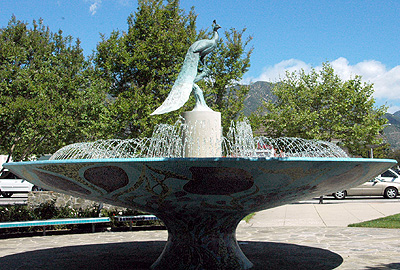 |
|---|
The City of Arcadia describes itself as, "an upper-middle class community of approximately 53,000 people in an 11.2 square mile area in the San Gabriel Valley. It was incorporated in 1903 and became a Charter City in 1951. Arcadia is known for beautiful neighborhoods, warm character and a "community of homes" atmosphere. The City places great emphasis on preserving “green space” and its commitment to the environment is evidenced by the large population of healthy trees you will find around town."
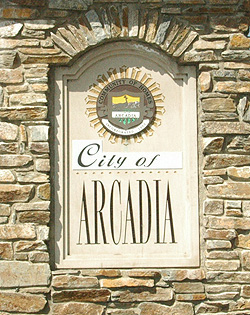 The land of Arcadia has its roots in Native American and Spanish heritages and in " Elias J. "Lucky" Baldwin. In 1875, Baldwin bought a large area of land including what is known as Arcadia for $200,000 ($25 an acre). When Lucky Baldwin first saw the land of Arcadia with its beautiful foothill landscape, lush greenery and oak trees, fertile growing land and acres full of potential, Lucky Baldwin was amazed and declared "By Gads!This is paradise." Upon buying the land, Lucky chose to make the area his home and immediately started erecting buildings and cultivating the land for farming, orchards and ranches. It didn't take log before he turned his sights to city hood for the blossoming area he named Arcadia.
The land of Arcadia has its roots in Native American and Spanish heritages and in " Elias J. "Lucky" Baldwin. In 1875, Baldwin bought a large area of land including what is known as Arcadia for $200,000 ($25 an acre). When Lucky Baldwin first saw the land of Arcadia with its beautiful foothill landscape, lush greenery and oak trees, fertile growing land and acres full of potential, Lucky Baldwin was amazed and declared "By Gads!This is paradise." Upon buying the land, Lucky chose to make the area his home and immediately started erecting buildings and cultivating the land for farming, orchards and ranches. It didn't take log before he turned his sights to city hood for the blossoming area he named Arcadia.
With a population of 500 and a booming economy that was somewhat based on entertainment, sporting, hospitality and gambling opportunities, Arcadia became a city in 1903. Since then, Arcadia has grown and matured into a city in which Lucky would have been proud – one of distinction, heritage, success and beauty. Thanks to the City of Arcadia for the historical information.
What's To Do In Arcadia?
There's the Arboretum of Los Angeles County
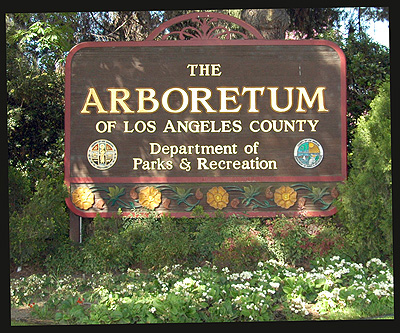 The Los Angeles County Arboretum & Botanic Garden is a 127 acre botanical garden and historical site filled with lush gardens. a citrus grove, an avocado orchard, a South American collection, a fig grove, a tropical greenhouse, a rose garden, a garden for all seasons and much more. Visitors can walk about or take the tram through the grounds.
The Los Angeles County Arboretum & Botanic Garden is a 127 acre botanical garden and historical site filled with lush gardens. a citrus grove, an avocado orchard, a South American collection, a fig grove, a tropical greenhouse, a rose garden, a garden for all seasons and much more. Visitors can walk about or take the tram through the grounds.
The land was home to Native Americans, Spanish and Mexicans. 1875, Elias Jackson "Lucky" Baldwin bought Rancho Santa Anita, a ranch on a 2,000 acre artesian belt on top of the Raymond Hill Fault. In 1885 he built "Baldwin's Belvedere," today known as the Queen Anne Cottage. Lucky Baldwin supplied residents of the city of Arcadia with high quality combination of canyon and artesian water. Since 1936, movie and television locations have used Baldwin Lake as a stand-in for swamps, lakes, rivers and even South Pacific lagoons.
The Arboretum was created in 1948, when the State of California and County of Los Angeles jointly purchased 111 acres from Rancho Santo Anita Inc to create an arboretum built around the Baldwin home-site. Through the years buildings and gardens were added. See 2005 Donna on the Side at Arcadia for a tour of the Arboretum.
There is a great deal of plant and animal life to see. One creature which is dominants the people area is the peacock. It's kind of pushy and noisy at times. But it is very pretty and colorful indeed. So much so that the Cityof Arcadia has incorporated it into its image and signage.
 |
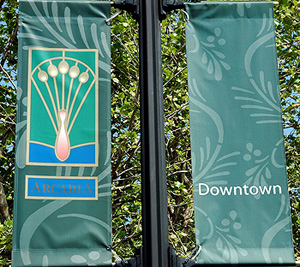 |
|---|
The Park and the Action
Santa Anita Park is a horse track with daily racing from December 26 through late April. In addition, the Oak Tree Racing Association holds races from early October to early November every year. Santa Anita consists of approximately 320 acres with a 1,100 foot long Grandstand, seating 26,000, gardens, monuments, a parklike track infield and many eating and drinking places. The track infield has a water fountain, playfield for children, gathering and picnic facilities. Off of the public areas are barns, with a capacity to hold more than 2,000 horses and a complete equine hospital.
The Santa Anita Park was designed as a beautiful park and not just a race track. With the opening Christman Day 1934, the design goal was accomplished and through the years it has been enhanced. It is a lovely place with buildings of a Spanish and Art Deco design, gardens filled with trees and colorful flowers. More than 1,500 trees, perennial flowers, water fountains, antique sculpture, and topiary shrubs designs fill the park. Every year the Park plants more than 9,000 flats of blooming flowers to enhance the park atmosphere. It's a beautiful and fun place.
 |
|---|
 |
| The San Gabriel mountains provide a spectacular backdrop for the Park. |
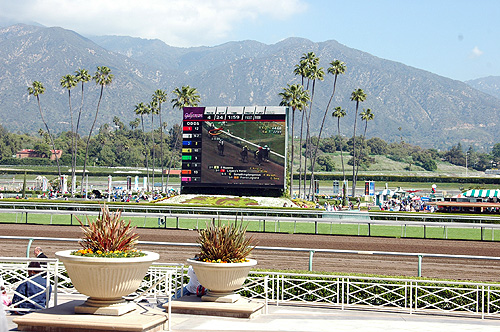 |
 |
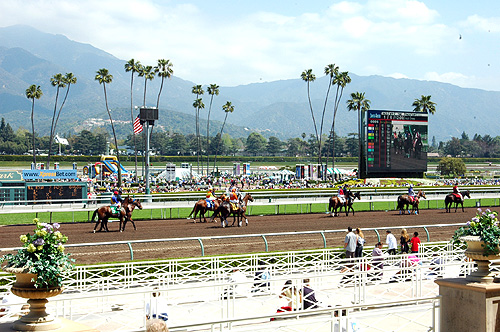 |
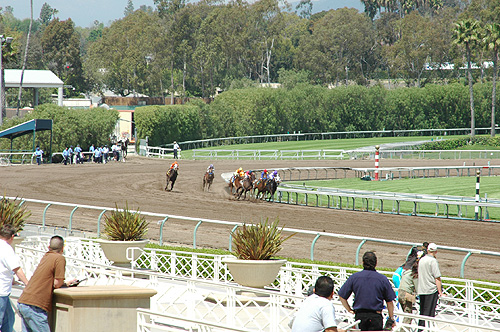 |
| Place your bets....free info and tips about horses running races during the day. |
|---|
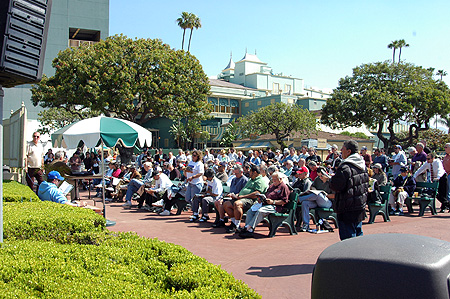 |
| Get a close up look at the horses while they are readied for the race. |
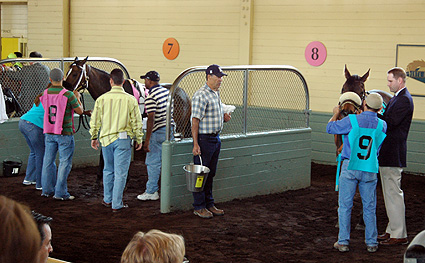 |
| Study the horses and jockeys going out to the track. |
 |
 |
| Fountain in the infield provides a relaxing spot to lounge. |
 |
| It's a festive atmosphere. |
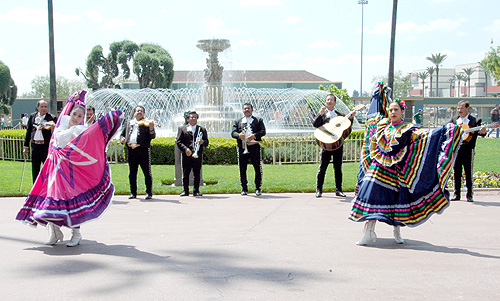 |
| Have a drink, eat a sandwich, decide on your picks. |
 |
| The most beloved and famous horse that ran at Santa Anita is Seabiscuit. A bronze statue of Seabiscuit stands in the center of the Gardens' Walking Ring. |
|---|
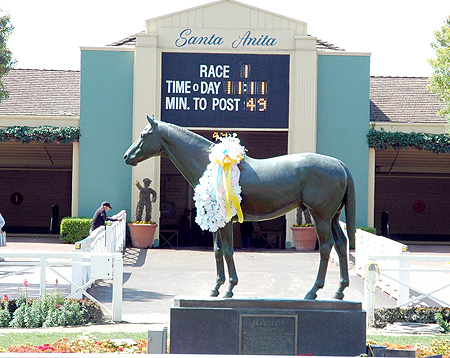 s s |
George Woolf, Seabiscuit's jocky has a home in Santa Anita Park. |
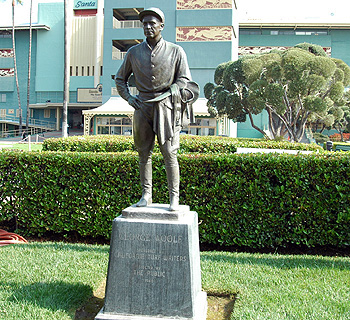 |
| Famous jockeys immortalized |
 |
Joe Hernandez, the original voice of the Santa Anita. He called the first of 15, 587 consecutive thoroughbred races at Santa Anita from the opening day until January 27, 1972. |
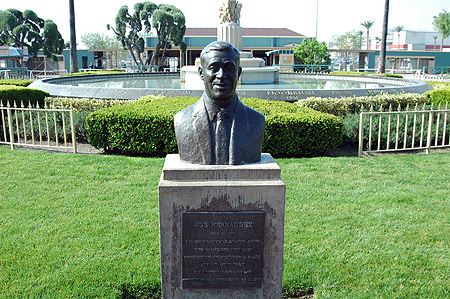 |
 |
"Fighting Furrari", who played Seabiscuit in the movie, gives John Dye a look. |
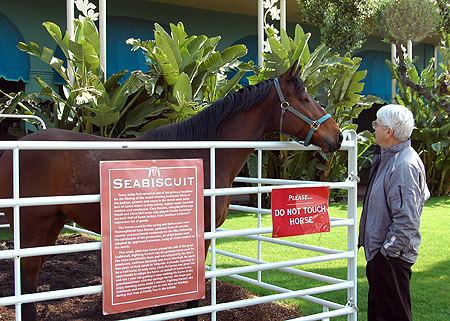 |
Santa Anita Park was one of the primary locations for the filming of the movie Seabiscuit. Many of the jockeys, grooms and extras in the movie were members of Santa Anita's jockey colony, trainer roster, backside workers and employees. There were five horses that played the role of Seabiscuit. Fighting Furrari was the primary horse to play Seabiscuit. The horse now resides in the grandstand barn with the carriage horses. (from the sign posted on the fence.) |
| Fun to look at topiaries |
|---|
 |
 |